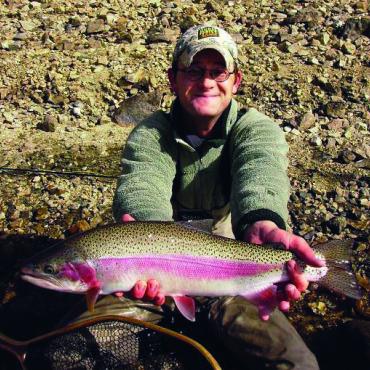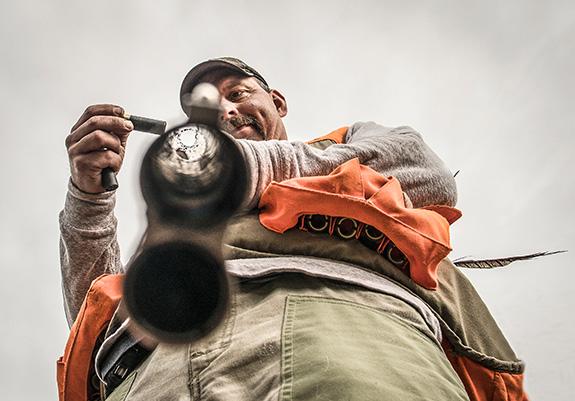Buyin' the Boomstick
Getting the right firearm for you.
Aside from the Bible, Shakespeare, and the Battle of the Little Bighorn, few subjects have drawn as much ink from pen as hunting-firearm selection. To say tomes have been written on the subject would be an understatement. In Montana, we have access to some of the most diverse and abundant game in the country, and when it comes to picking a weapon of choice, one size doesn’t fit all. Before laying down those hard-earned dollars, ask yourself these basic questions: Am I hunting birds, small game, big game, or all three? What species am I going to spend the majority of my time pursuing? How heavy of a rifle or shotgun am I comfortable carrying and shooting? Do I want to buy new or used? What type of scope do I need? And finally, what’s my budget?
Information & Education
For the uninitiated, wading into the complex and ever-changing world of firearms, ballistics, and optics is not only intimidating, but can be downright confusing. Especially if one happens to get caught up in the “New Shiny Thing” syndrome where every gun blog, hunting and shooting magazine, and discussion board is awash with the latest and greatest, or rediscovered and revamped. It’s easy to get carried away.
Start with the basics. Educate yourself on the tried-and-true caliber or gauge for the game you’re most likely to pursue. Understand the anatomy and behavior of your chosen quarry and you’ll be better off when selecting a shooting iron. Not unlike pickup trucks and fly rods, shotguns and rifles are a serious investment, and the more information you have on the front end of your gun purchase, the happier you’ll be with it in the field or on the range. Among my favorite references is The Complete Book of Rifles and Shotguns by Jack O’Connor. Although slighted dated, it’s considered by many to be the beginning-gunner’s bible, and unlike many gun books, it’s actually fun to read. Other good resources include American Hunting Rifles by Craig Boddington, The Shotgun Encyclopedia by John Taylor, and the Blue Book of Gun Values by S.P. Fjestad. These books, in conjunction with friends and a few credible internet resources such as rokslide.com and various manufacturer websites, should help narrow things down to a few choices. At this point, hit up a local gun counter for advice before making your final selection.
Caliber & Action
Making a broad-based, one-size-fits-all caliber recommendation for Montana game would be akin to saying that only one kind of meat is suitable table fare. I don’t believe that about meat or rifles. There are hundreds of centerfire rifle cartridges, and with the recent advancements in short-magnum rounds, choices in hunting calibers seem more numerous than ever. A wiser man than myself once told me that the best caliber for Montana big game was the biggest one that you could shoot comfortably and consistently. This same advice goes for rifle actions. Some folks swear by single-actions, while others are devoted to semi-autos. Some are tied to tradition and won’t shoot anything but bolt-actions or levers. The best choice for you is the rifle that enables you to make that necessary kill shot each and every time—and if necessary, the follow-up shot as quickly as possible, to be sure that your hard-won meat stays down. An ideal way to try different calibers and actions is to get some of your prospective hunting buddies together for a sight-in day or inquire with local sporting goods retailers about demo days. Shoot as many different calibers with different actions as you can. Getting solid real-world shooting experience with different firearms will help to define which ones you like or dislike.
Gauge & Action
When it comes to shotguns, things are slightly less complicated. Most off-the-rack shotguns in the U.S. come in four gauges: 410, 20, 12, and 10. The 10-gauge is the biggest a dozen or so rounds will beat the tar out of even the most dedicated shotgunner. A 410 is great for training youth hunters, or for those folks chasing dove, partridge, or smaller grouse. The 20-gauge is great for youth hunters looking to get more serious about waterfowl or larger upland birds, or close-range deer hunting with buckshot or slugs. The 12-gauge may very well be the holy grail of shotguns, as it is perhaps one of the most versatile firearms available. Due to the vast array of loads, optional accessory barrels, and ready availability, the .12-gauge is often the most-used gun in a hunter’s arsenal.
Shotgun actions are as diverse as rifle actions; however, the most popular actions for hunting are as follows: single-shot breach loaders, over-under breach loaders, pump-action, and semi-autos. Again, the choice of action depends on preference, personal comfort, and the type of game you’ll most likely be hunting. Explore all your options and find the shotgun that is the quickest and most accurate for your shooting style.
Weight
Standing in flip-flops at the gun counter is a far cry from your tenth mile into the backcountry or the fifth mile along a crop line. Weight matters. Consider the composition of the gun: most modern firearms have stocks made of wood or synthetic composite material. Synthetics tend to be lighter and more durable, but the lack of heft can increase felt recoil. This is where your personal comfort becomes paramount. Any hunting firearm should be an extension your body; if an arm or leg is overly heavy, too light, or painful or awkward to use, its effectiveness is drastically impaired.
New or Used
This can be a tricky labyrinth to navigate. You get what you pay for, be it in product or service. When it comes to guns, buy the absolute best you can afford, and if you can’t afford it, save up, or sacrifice in some other area so that you can. If the gun you’re looking at appears new, but is in fact used, you may be buying someone else’s problems. Some guns just don’t shoot right—don’t get stuck with one. Build a good relationship with your local gun dealers and gunsmiths. Make sure that they are serious hunters, too, not just shooters. Most reputable gun shops are very interested in keeping their customers happy, and will do their best to get you the gun you want, because they want you to come back.
Optics
Here is another area where it pays to save, and then save a little more. Buy the best you can afford, or perhaps incur a tolerable amount of debt to have the best. There are two basic types of telescopic scopes: fixed and variable power. Always consult your gunsmith to match your weapon with the best scope for your hunting needs. It’s important to note that scopes are not just for rifles anymore. If your primary targets with your shotgun happen to include wild turkeys or deer, it could be beneficial to look into scoping up your scattergun.
Kurt Dehmer owns Durty Kurty’s guide service.












